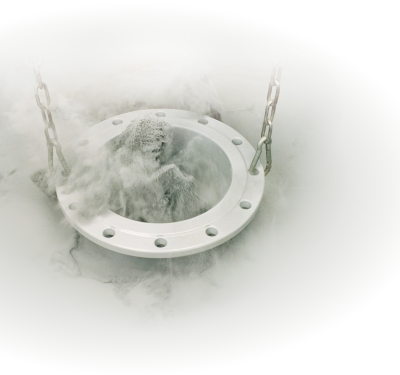Fluidized Bed Coating
A non-porous protective layer
Fluidized bed coating is a process in which pre-heated components are immersed in a bath containing powder. Air is blown through the porous floor of the bath, which keeps the powder particles moving and makes it behave like a liquid. When the sandblasted and heated component is immersed in this fluidized bed, the powder particles melt on the product producing a non-porous layer with a thickness of about 400 μm.
Efficient with no powder wasted
We apply Rilsan®, Resicoat® or Abcite® coatings to large and small components using the fluidized bed technique. It is a controlled method for applying coating on both the inside and outside in one single operation, reaching spaces that are difficult to access. We use this technique particularly for pipeline components, connectors and auxiliary pieces. With this process we are able to coat components up to 6 metres length with diameters up to 1.5 metres.
Electrostatic powder coating
One or more protective layers
Electrostatic powder coating of complex components is mainly a manual process. The powder acquires an electrical charge inside the spray gun for proper spraying on the metal surface to be coated. Depending on the coating, we apply this technique to cold or pre-heated surfaces. The process will be repeated when necessary to obtain a greater layer thickness. Rilsan®, Resicoat®, Halar®, Abcite® and fluoropolymers such as ETFE and PFA Ruby Red are suitable coatings for this technique.
Benefits of electrostatic powder coating
As we apply the coating manually, we can target specific surfaces of metal products very precisely. This method enables us to coat complex components such as tanks, valve casings and racks or frames for galvanization processes. Moreover, this technique makes it easy to switch coatings, so that the costs of changeovers are limited.
Frequently asked questions
Rotomoulding is a coating technique in which the part to be coated is heated and turned. The coating material will be distributed all over the surface and will melts down as a solid layer.
With this coating technique the powder in side the spraying-gun is electrically charged. The powder then settles on the metal surface that needs to be coated. Depending on the coating this is applied to a cold or a pre-heated metal surface. With a number of coatings this can be repeated in order to achieve a higher layer thickness.
Fluidized bed coating is a process in which preheated parts are immersed in a powder bath. This powder is kept in vortex by blowing air through the porous bottom of the bath. This causes the powder to behave as being a liquid. When the blasted and heated part is subsequently immersed in the whirlpool bath, the powder particles melt down as a solid layer.
Thermal cleaning is a method of removing old coatings. It is also possible to clean contaminated parts and auxiliary tools that are used in companies that produce coatings. In our pyrolysis furnace parts are heated up to 450 ° C in an oxygen-poor environment. The gases from the pyrolysis are burned in an afterburner at 850 ° C for 2 seconds, after which the gases are cooled and will finally pass through a scrubber. With this installation we can remove old coatings in an environmentally responsible manner.
The following components are used for dry film lubrication: PTFE, graphite and Molybdenum disulphite (MoS2). These products reduce friction so that no oils and fats are required. These coatings are mainly used in clean rooms.
Abrasion resistance is the degree to which a coating is resistant to wear. It should be noted that certain coatings are more resistant to abrasive wear than others, but no coating will be able to fully prevent abrasive wear.









